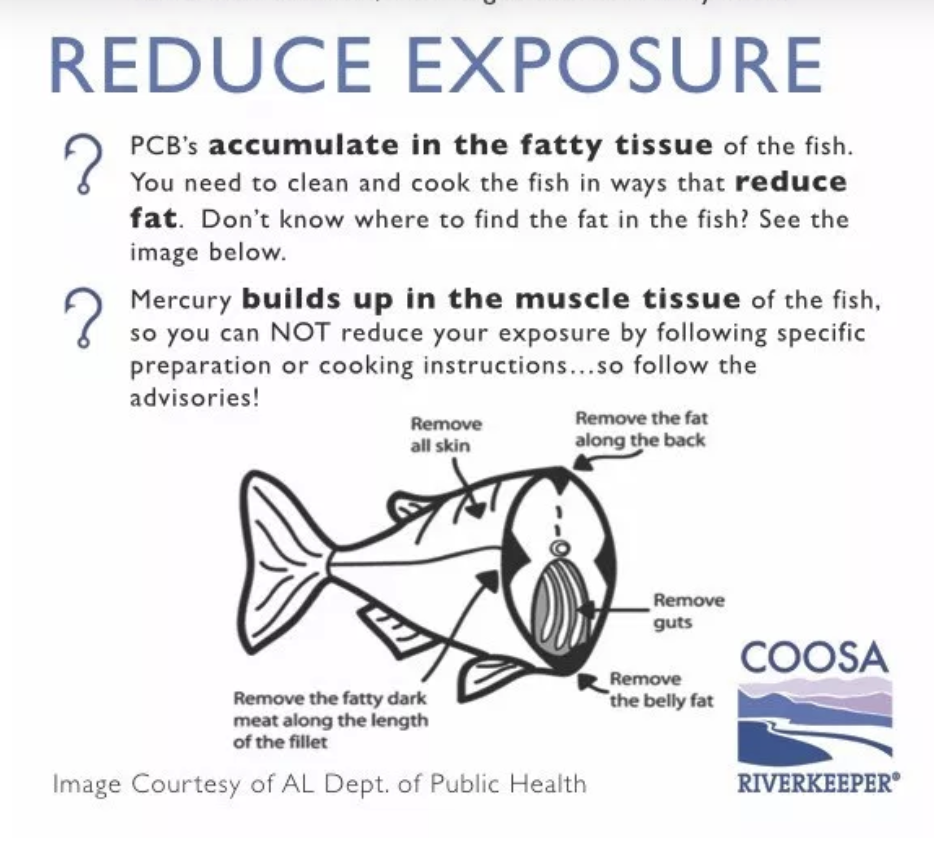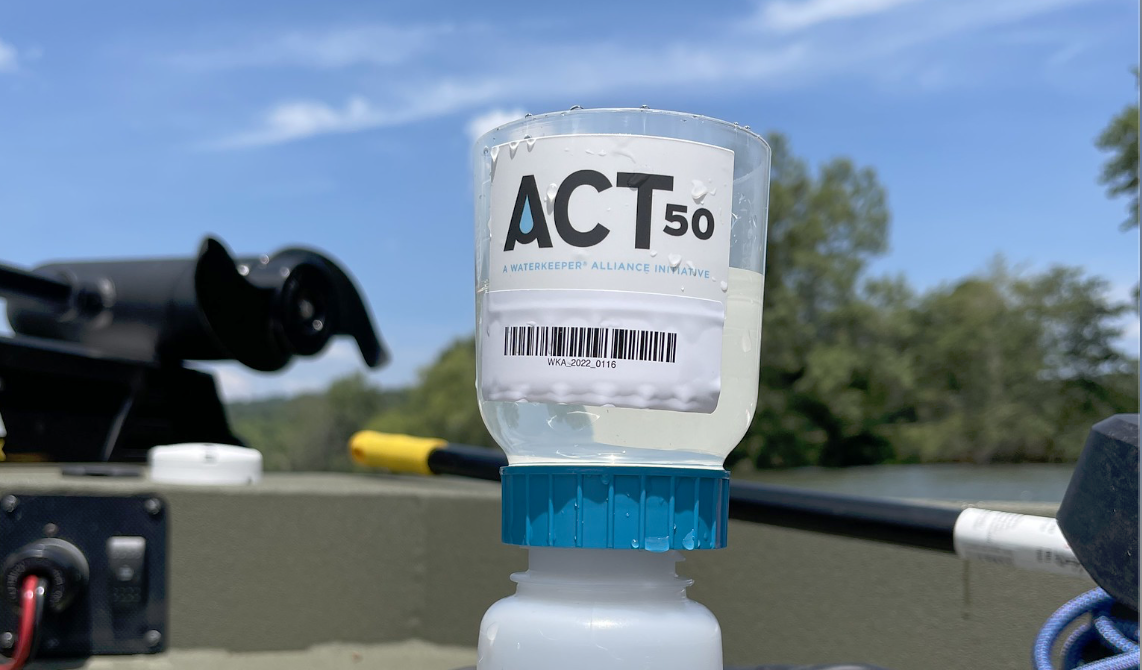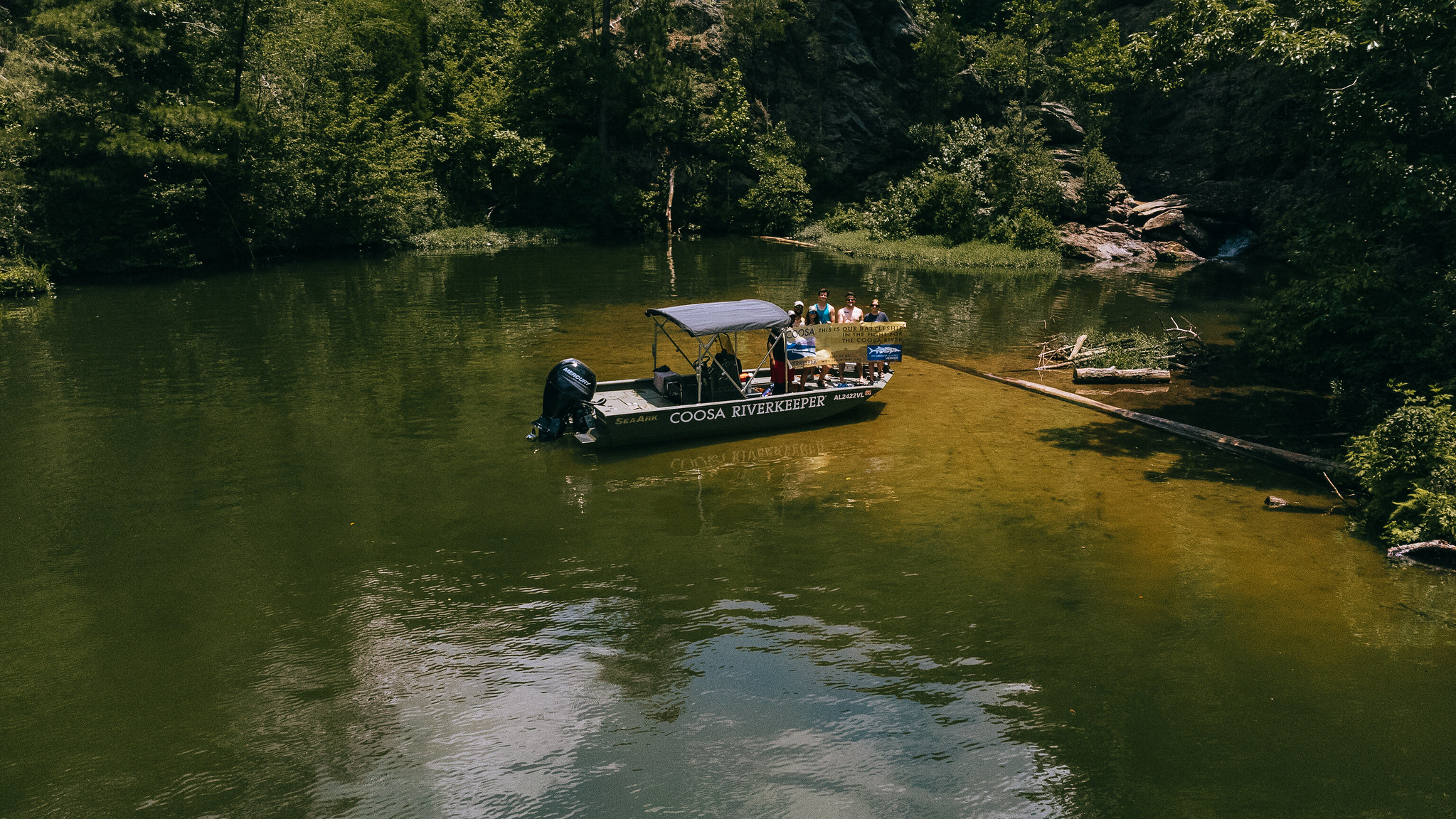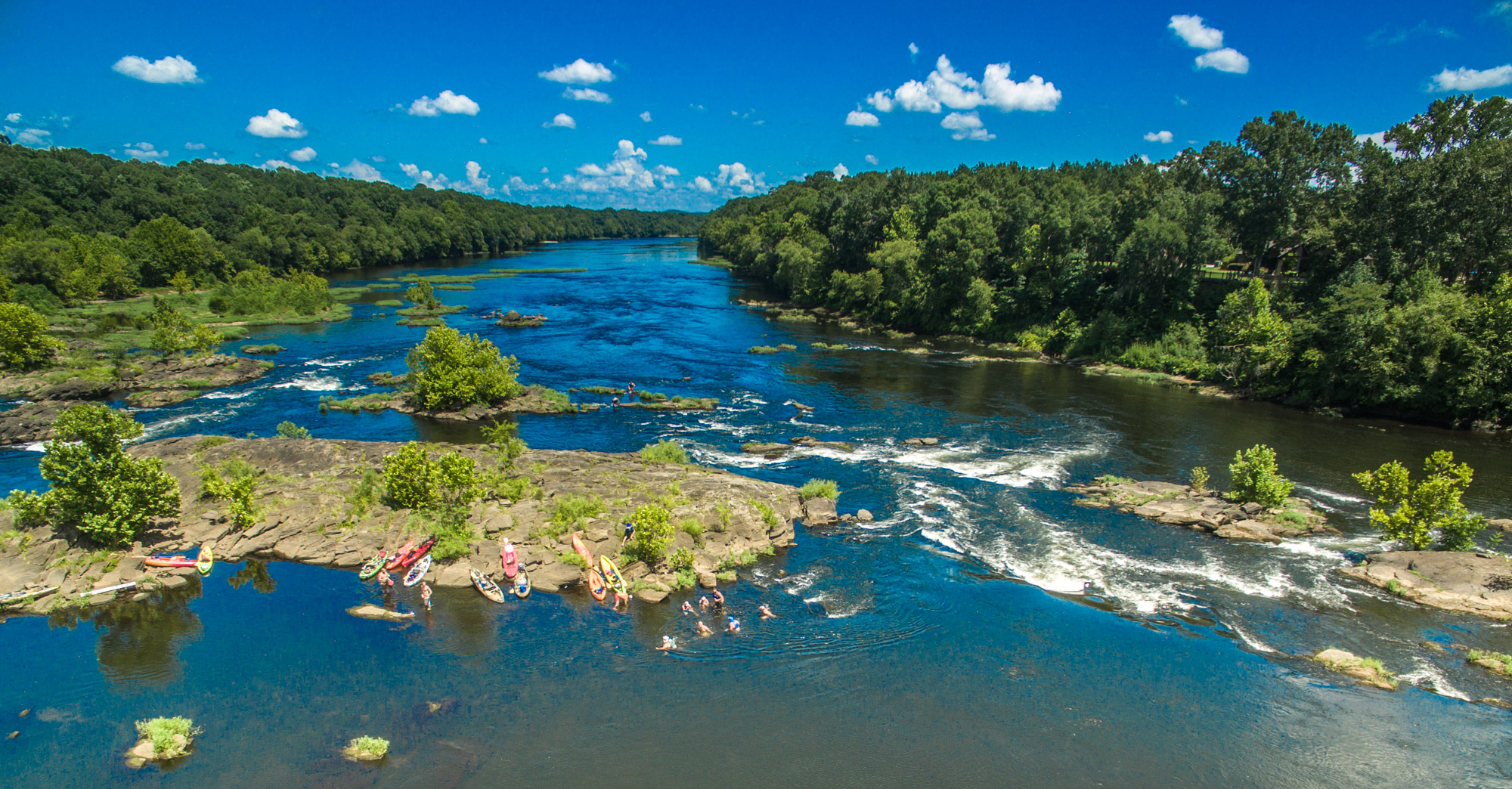Fish Consumption Advisories
Dive into fish consumption advisories by checking out our interactive map, calling our statewide hotline, and learning how to reduce your exposure to harmful contaminants in your catch.
Cookin’ your catch
Cast in the Coosa
ANGLER ADVOCACY
Can You Eat Your Catch?
Although we love a good fish fry, it’s important to remember that the fish we catch can spend their whole lives swimming through a polluted environment. Fish caught from polluted waters can be contaminated with heavy metals and man made compounds that are dangerous to our health. Eating fish containing pollutants may cause birth defects, liver damage, cancer, and other serious health problems over time. Find out where the fish are contaminated on the Coosa and learn how to minimize your exposure.
The Alabama Department of Public Health issues fish consumption advisories for specific fish species on specific bodies of water for a particular contaminant. It is not illegal to eat fish under an advisory but it is recommended to heed the advisory because the contaminants can accumulate in your body over time causing long-term health impacts.
If a waterbody or species of fish is not listed that means the waterbody hasn’t been sampled, there isn’t enough data, or the waterbody is privately owned… that does not necessarily mean it is safe to eat.
Explore the Current Fish Consumption Advisories by Reservoir
Weiss
No current advisories.
The image below is a summary of the current fish consumption advisories on this lake:

Neely Henry
No current advisories.
The image below is a summary of the current fish consumption advisories on this lake:

Logan Martin
On Logan Martin Lake in its entirety, do not eat any Striped Bass. It is advised to limit consumption of blue & channel catfish and spotted bass to 1 meal per month.
On Choccolocco Creek it is advised to not consume any quantity of any species of fish.
The image below is a summary of the current fish consumption advisories on this lake:

Lay
For Lay Lake in its entirety, limit consumption of striped bass to 1 meal per month. It is advised to limit consumption of largemouth bass to 1 meal per month. It is advised to limit consumption of catfish to 1 meal per month. Do not eat any spotted bass.
The image below is a summary of the current fish consumption advisories on this lake:

Mitchell
No current advisories.
The image below is a summary of the current fish consumption advisories on this lake:

Jordan
No current advisories.
The image below is a summary of the current fish consumption advisories on this lake:


Use the map below to find exactly where the advisories are issued on the Coosa River & Lakes

Learn more about PCBs and Mercury in the Coosa
Mercury Health Impacts
It is an neurotoxin.When methylmercury is present in fish tissue, it can cause damage to your nervous system, kidneys, and lead to heart disease.
Listen up ladies! Women who consume fish with mercury before/during pregnancy increase their risk for developmental issues in their children.
How Mercury Enters the Food Chain
Atmospheric deposition of mercury (explained in the infographic below) is a leading cause of fish contamination on the Coosa River and every single river in Alabama, The River State.
There are two steam plants on the Coosa in Alabama. The Ernest C. Gaston Steam Plant in Wilsonville on Lay Lake which is transitioning to natural gas. The Gadsden Steam Plant in Gadsden on Lake Neely Henry just recently closed. When any plant burn fossil fuels, mercury is released into the atmosphere falls with rain/dust, and then enters the food chain… don’t get me started on the impacts of Alabama Power’s coal ash ponds that are contaminating groundwater AND sitting next to the Coosa River upstream from two major drinking water intakes…
These steam plants and their relationship with mercury:
- The E.C. Gaston Plant is Alabama Power’s third largest fossil fuel plant.
- Gaston Steam Plant on Lay Lake is a major emmitter of pollutants.
- In 2008, the Environmental Integrity Project, ranked the Gaston Steam Plant second in the nation in the amount of arsenic dumped on-site.
- The plant was also Alabama’s largest polluter in 2009 when it sent 3.8 million pounds of toxins into the air.
- It has also in the past been ranked as second in the nation for air emissions of mercury.
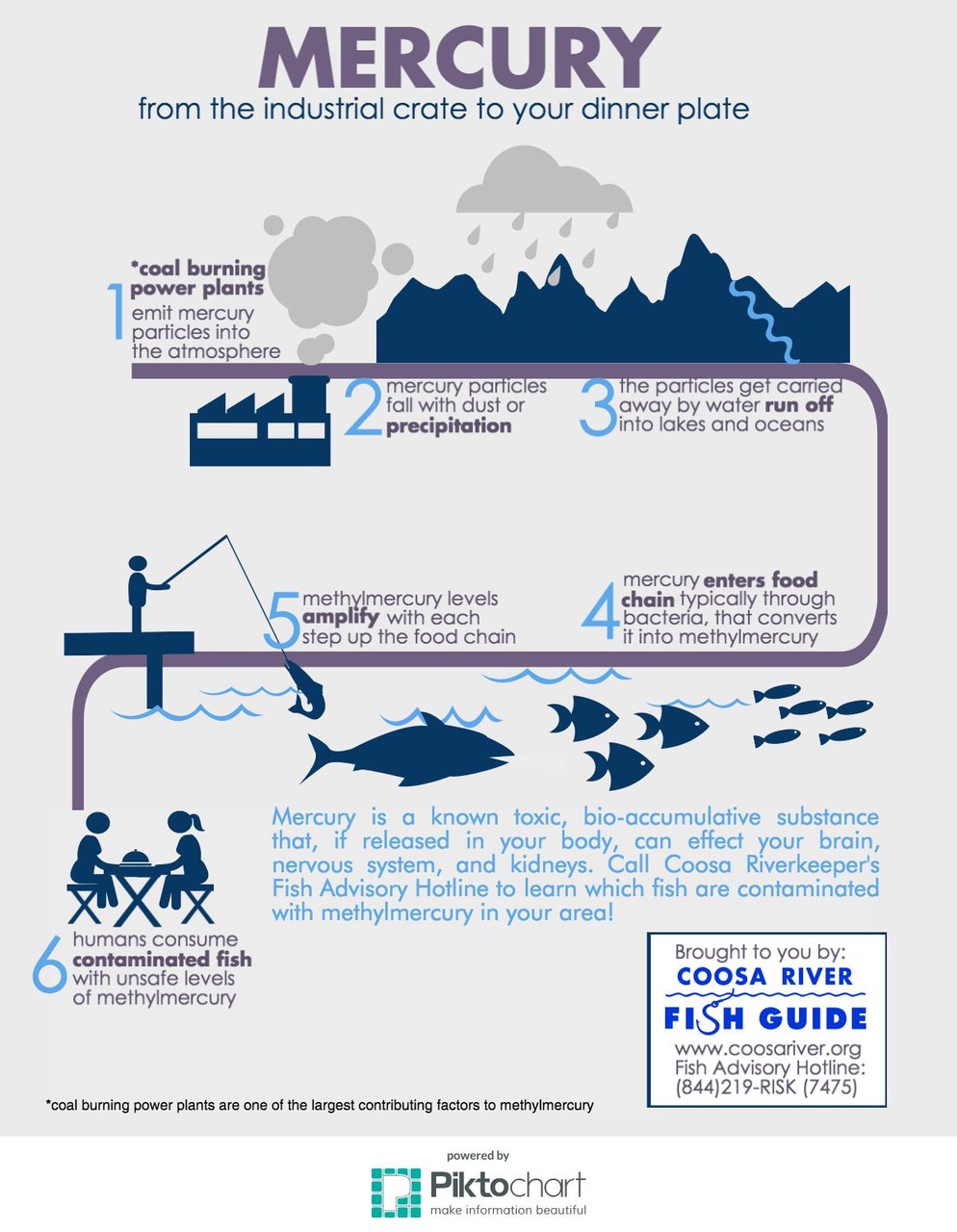
How to Reduce Mercury Exposure
Portions Matter when it comes to Mercury!
For fish consumption advisories for mercury, it doesn’t matter how you prepare your catch or how you cook it. Mercury is stored in the fish tissue so you there is not much you can do you reduce your exposure… except for following the advisories themselves and maintaining the recommended portion (the size of a deck of cards)!

PCB Health Impacts
Polychlorinated biphenyls (PCBs) have no odor and range from colorless to light yellow. They are mixtures of 209 individual chlorinated compounds. PCBs can enter the air, water, and soil during the manufacture, use, and disposal as well as accidental leaks or spills during transport.
Reproductive Effects: Children of women exposed to PCBs have shown a decreased birth weight. PCBs can be passed through breast milk.
Immune Effects: Studies have revealed suppressed immune systems in individuals exposed to PCBs.
Neurological Effects: Studies have shown that animals and humans exposed to PCBs have shown significant neurological deficiencies in children (learning, visual recognition).
Endocrine Effects: People who have been exposed to PCBs have shown decreased thyroid hormone levels, which are extremely important for normal growth and development!
Studies conducted in the late 1970s have provided conclusive evidence that PCBs causes cancer in animal. Studies done on humans strongly suggest PCBs are a probable carcinogen. Additionally, PCB composition changes after it is released into the environment! The types of PCB compounds that bioaccumulate in sediment, fish, and other animals are said to be the most carcinogenic. As a result, folks who eat these fish and animals are exposing themselves to more toxic PCB compounds.
History of PCBs in the Coosa
In the 1930s, electrical appliances were growing in popularity across the nation, which also increased the need for PCB manufacturing.
In 1935, Monsanto purchased the Swann Chemical Company in Anniston and began commercially manufacturing PCBs for the first time in the U.S. During its forty years of manufacturing, the Monsanto Company (now called Eastman) flushed tens of thousands of pounds of PCBs into nearby creeks, specifically tributaries of Choccolocco Creek, and buried in a landfills. They produced PCBs at the Anniston plant until 1971, 8 years before PCBs were banned by the federal government.
PCBs were used as an industrial lubricant in heavy machinery and were banned by 1979. They were also used in paints, newspaper adhesives, deep fat fryers, and bread wrappers.
How to Reduce Your Exposure to PCBs
CBs are found in the fatty tissue of the fish. In order to reduce your exposure you need to clean the fish to remove all the skin and fat. In addition, it is important to remember
DO NOT reuse your frying oil multiple times… (we get it, that’s what grandma did ’cause the seasoning is better)!
PCBs are a fat soluble contaminant, so be mindful of how you prepare and cook your catch!
